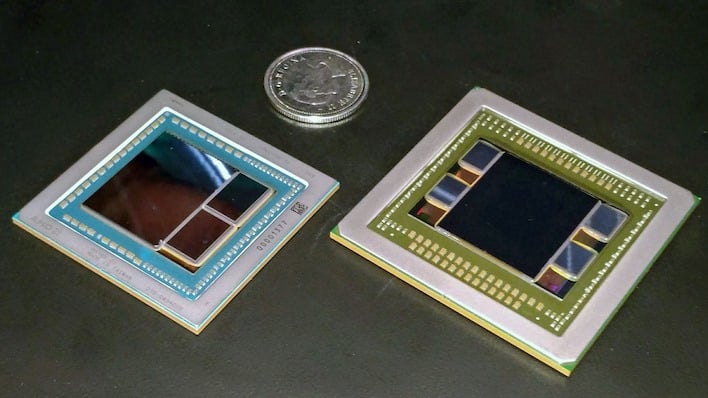The source in question is occasional leaker and hardware rumor connoisseur Everest, perhaps better known as @Olrak29_ on Xwitter. He shared a render of a processor package that appeared to be Vega 64 back in April, with text overlaid that said “Oh sh*t, it’s Vega 64.” However, sharp-eyed users noted that the dimensions weren’t quite correct. Now, Everest has revealed that the render is of a Strix Halo processor.
The design is bizarre. It apparently centers around a single large chip that includes graphics, SoC functions, and some number of “Zen 5 LP” processor cores. Then, two eight-core Zen 5 CCDs are attached to the chip using Infinity Fanout links. Another users asks if the interconnect is “Zen 6-like”, to which Everest says “Strix Halo gets it first,” implying that this may be a new type of interconnect altogether.
While some have posited that the Zen 5 CCDs appear to be different in some way from the chiplets that will be used in the Granite Ridge desktop processors, to our eyes the specifications match up. However, the specifications that Everest gives for the “GCD” of Strix Halo are very curious. We already knew about the 20 WGP graphics processor based on the RDNA 3.5 architecture; that’s a bigger GPU than a Radeon RX 7600 XT.

We’re also not surprised by the 256-bit memory interface nor the “>40 TOPs XDNA 2” NPU. The NPU matches up with what has been leaked for Strix Point; it’s likely the same configuration. Meanwhile, the wide memory bus, while unorthodox, is practically necessary to support that massive GPU. There’s noted to be 32MB of Infinity Cache on the massive die, but that’s only going to get you so far without some serious main memory bandwidth. Thankfully, 256-bit LPDDR5X could be as much as 275 GB/second of memory bandwidth, equal to a GeForce RTX 4060.
The really fascinating information is the vague “Zen 5 LP” listing. Many people speculated, when Strix Halo was first rumored to have 16 cores, that some of the cores would be Zen 5C dense cores. However, later rumors confirmed that all 16 cores are full-fat Zen 5 CPU cores. The idea that the main die in Strix Halo may include even more CPU cores is very curious, but it smacks of the “LP E-Cores” included on the SoC tile in Intel’s Meteor Lake processors.
Strix Halo will be a BGA design, which means it will primarily find a place in laptop machines and small-form-factor desktops. Hopefully someone produces an SFF desktop with one of these parts that’s capable of cranking the power limit through the ceiling. Slap SteamOS on it, and such a system could make for an awesome “PC console”, like a Steam Deck for your entertainment center. We’ll probably find out more about Strix Halo at Computex in early June.
